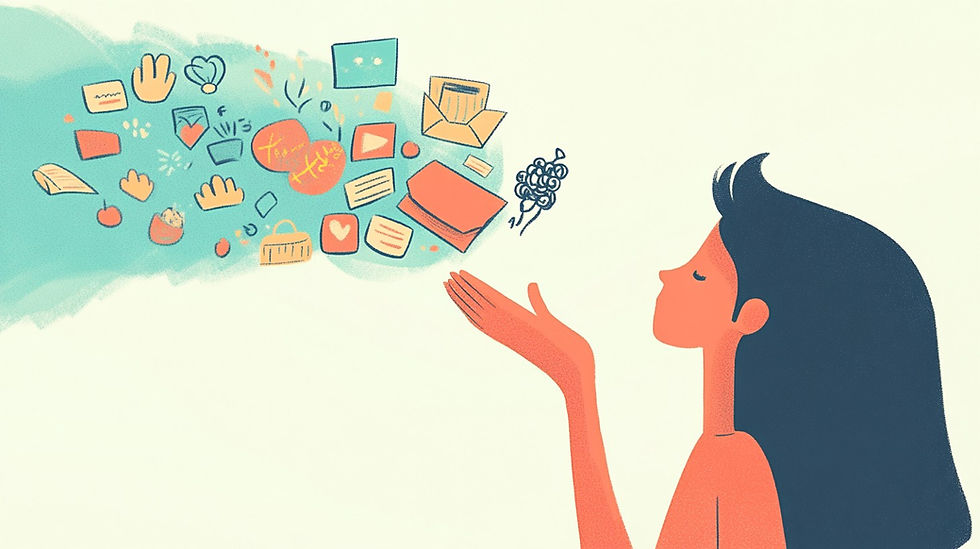Find Your Flow: 4 Zen-Inspired Steps to Meaningful Decluttering
- Carl
- Apr 16
- 4 min read

In our busy modern lives, the state of our homes often reflects the state of our minds. Clutter isn't just physical untidiness; it can contribute to mental noise, stress, and a feeling of being overwhelmed. Embracing principles inspired by Zen philosophy, such as mindfulness, simplicity, and non-attachment, can transform decluttering from a tedious chore into a mindful practice – a way to cultivate peace and clarity both in your surroundings and within yourself.
This isn't about stark, empty rooms (unless that brings you peace!). It's about consciously choosing what surrounds you, making space for what truly matters, and creating an environment that supports your well-being. Ready to begin? Here are four practical, Zen-inspired steps to guide your decluttering journey.
Apply the Time Test (e.g. The One-Year Rule)
The Concept: A common guideline is the “One-Year Rule”: if you haven’t used an item in the past year, it’s a strong candidate for letting go.
The Deep Dive: This rule directly challenges the “but what if I need it someday?” impulse that keeps clutter anchored in our homes. A year is a significant cycle, covering all seasons and typical life events. If an item hasn’t found a purpose within that timeframe, its necessity is questionable. Variations exist, like the 90/90 rule (haven’t used it in 90 days, won’t use it in the next 90?), which can be useful for faster-moving categories like clothing or project supplies.
Of course, apply this with wisdom. Exceptions exist for high-value, hard-to-replace items, emergency supplies, or deeply sentimental pieces. However, be honest with yourself. Are you keeping it out of genuine need/love, or out of habit, guilt, or undefined future fear? This step encourages a mindful assessment of an item’s actual role in your current life, not a hypothetical one.
Consult Your Inner Compass: The Joy Check
The Concept: Popularized by Marie Kondo, this involves holding an item and asking yourself: “Does this spark joy?”. The aim is to surround yourself only with things that elicit a positive feeling.
The Deep Dive: This is less about fleeting happiness and more about a deeper resonance. When holding an object, pay attention to your physical and emotional response. Kondo suggests looking for a “thrill,” a feeling of lightness. However, “joy” is subjective; it might manifest as a feeling of deep appreciation, calm, usefulness, or simply recognizing an item as essential and supportive of your life. For functional items, the "joy" might come from how well they perform their task or how they make your life easier.
Critically, the focus shifts from deciding what to discard (which can feel negative) to actively choosing what to keep. You are curating your environment based on positive affirmation. For items that don’t make the cut, the KonMari method advises thanking them for their service before letting them go. This act of gratitude can lessen guilt and foster appreciation for the things you do keep.
Address the Echoes: The Duplicates Dilemma
The Concept: Intentionally identify items where you own multiples serving the same basic function. Assess which is your favourite or most effective, and consider releasing the extras.
The Deep Dive: We often accumulate duplicates unintentionally – we buy a replacement forgetting we had one, receive gifts, or stock up “just in case.” While having backups of essential consumables is practical, an excess of duplicates (think multiple spatulas, dozens of pens, numerous similar clothing items) creates unnecessary clutter and complicates storage.
To tackle this effectively, gather all similar items together from wherever they live in your home. Seeing the sheer volume can be illuminating. Then, evaluate: Which one works best? Which feels best to use? Which fits your needs most accurately? Which do you reach for instinctively? Keep the best, and let the others go to someone who might need them. Assigning a clear “home” for the keeper(s) also prevents future clutter. Reducing duplicates simplifies your inventory, streamlines choices, and frees up significant space.
Create Breathing Room: The Maybe Box
The Concept: If you're genuinely undecided about an item, place it in a designated "Maybe Box". Revisit the box after a set period.
The Deep Dive: Decluttering requires decision-making, which can be fatiguing. The Maybe Box is a tool to handle temporary indecision without derailing your progress. It allows you to clear the space you're working on while giving yourself permission to defer a tricky decision.
Best practices include:
Using an opaque box: Out of sight, less likely to constantly remind you.
Setting a deadline: Choose a specific timeframe – one month, three months, or even six. Put a reminder on your calendar.
Storing it away: Keep it somewhere accessible but not in your daily line of sight.
The Test: The crucial part is how you interact (or don't interact) with the box during the set period. If you needed something from the box and retrieved it, that item likely earns its keep. If the deadline arrives and you haven't needed anything, missed anything, or even remembered what's inside, it's a strong indicator that you can let those items go with confidence.
Use this tool judiciously. It's meant to aid decision-making, not become a permanent holding pen for clutter or a method for avoiding decisions altogether.
Embarking on a decluttering journey using these mindful steps is about more than just tidying up. It's an opportunity to connect with your belongings, understand your habits, and intentionally shape an environment that fosters peace, clarity, and calm. Be patient and compassionate with yourself throughout the process. The goal isn't overnight perfection, but a gradual shift towards a home that truly supports and reflects the life you want to live.



Comments